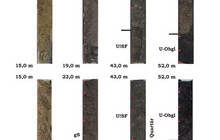Geology: Study of selected section areas of the exploratory drilling in the forefield of the surface mine Jänschwalde
To clarify geological issues, geochemical point of views can provide helpful arguments. At this project we have been instructed to run an element screening at a drill core using the XRF handheld device and perform an evaluation of the element content. At this Saalian tills, the Quaternary-Tertiary-boundary and the “Oberbegleiter” of the 2nd Lausitz seam were of interest, as well as the interburden 2 within the 2nd Lausitz seam. The trace elements allow a geochemical division, which was able to support the slightly shaky areas of the geological classification.
- Despite of the strong color change the Saalian till (picture a) to d)) was able to be considered geochemically as unit with sharp boundary to the underlying fine sand.
- At the base of the Quaternary-Tertiary-boundary a reworking horizon can be observed, which shows signatures in the trace elements of the Elsterian hanging wall till and the Tertiary footwall fine sand (picture e) and f)).
- The footwall fine sands (G4) of the “Oberbegleiter”, which is formed as silt, are geochemically distinguished from the hanging wall fine sands (G3) in many respects. This is shown by the genetic diversity of the section part (picture g)).
- Regarding the geochemical as well as geological interpretation the interburden of the 2nd Lausitz seam was evolved highly differentiated. Due to its diversity interesting conditions of formation are suggested.
Besides, having over 100 measuring points one was able to compose geochemical element correlations. The high density of geochemical data is a useful addition to geophysical borehole measurements and geological studies.
project overview
- Disposals by the wayside
- Deposits in systems of industrial facilities
- Analytics of fibers
- Microscopic analysis of construction material
- IHS-Cinder-Conditioning
- Seam anomaly in the open-pit mine Welzow-Süd
- Sediment petrographic investigation of the Meuro Formation
- Scanning Electron Microscopy of dust precipitations
- The "Venus" vom Hohle Fels
- Investigation of corrosion in plant engineering and construction
- Study of clinker formation in power plant processes
- Survey of geological structures using GPS
- Maceral analysis and microscopic evaluation of peat samples
- Evaluation of a coal seam sequence in the surface mine V. Schleenhain
- Coal quality treatments
- Faciel correlation of archeological findings
- Mapping of sulfur content
- QMAT
- Study of selected section areas of the exploratory drilling in the forefield of the surface mine Jänschwalde
- Xylite classification
- Cuticular analysis
Special methods
Mobile XRF analysis
Fast multi-analysis of elements with various possibilities and almost unlimited numbers of measurement points


